Salient Object Detection From Arbitrary Modalities
Paper and Code
May 06, 2024



Toward desirable saliency prediction, the types and numbers of inputs for a salient object detection (SOD) algorithm may dynamically change in many real-life applications. However, existing SOD algorithms are mainly designed or trained for one particular type of inputs, failing to be generalized to other types of inputs. Consequentially, more types of SOD algorithms need to be prepared in advance for handling different types of inputs, raising huge hardware and research costs. Differently, in this paper, we propose a new type of SOD task, termed Arbitrary Modality SOD (AM SOD). The most prominent characteristics of AM SOD are that the modality types and modality numbers will be arbitrary or dynamically changed. The former means that the inputs to the AM SOD algorithm may be arbitrary modalities such as RGB, depths, or even any combination of them. While, the latter indicates that the inputs may have arbitrary modality numbers as the input type is changed, e.g. single-modality RGB image, dual-modality RGB-Depth (RGB-D) images or triple-modality RGB-Depth-Thermal (RGB-D-T) images. Accordingly, a preliminary solution to the above challenges, \i.e. a modality switch network (MSN), is proposed in this paper. In particular, a modality switch feature extractor (MSFE) is first designed to extract discriminative features from each modality effectively by introducing some modality indicators, which will generate some weights for modality switching. Subsequently, a dynamic fusion module (DFM) is proposed to adaptively fuse features from a variable number of modalities based on a novel Transformer structure. Finally, a new dataset, named AM-XD, is constructed to facilitate research on AM SOD. Extensive experiments demonstrate that our AM SOD method can effectively cope with changes in the type and number of input modalities for robust salient object detection.
 Add to Chrome
Add to Chrome Add to Firefox
Add to Firefox Add to Edge
Add to Edge